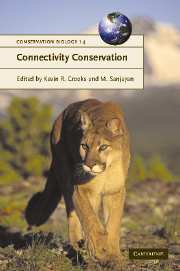Book contents
- Frontmatter
- Contents
- List of contributors
- Acknowledgements
- 1 Connectivity conservation: maintaining connections for nature
- PART I Approaches to connectivity research
- PART II Assessing connectivity
- Introduction: evaluating and quantifying the conservation dividends of connectivity
- 12 Quantifying connectivity: balancing metric performance with data requirements
- 13 Assessing connectivity in salmonid fishes with DNA microsatellite markers
- 14 Individual-based modeling as a tool for conserving connectivity
- 15 Linking connectivity to viability: insights from spatially explicit population models of large carnivores
- 16 Impacts of corridors on populations and communities
- 17 Exploring the functional connectivity of landscapes using landscape networks
- PART III Challenges and implementation of connectivity conservation
- Index
Introduction: evaluating and quantifying the conservation dividends of connectivity
Published online by Cambridge University Press: 24 May 2010
- Frontmatter
- Contents
- List of contributors
- Acknowledgements
- 1 Connectivity conservation: maintaining connections for nature
- PART I Approaches to connectivity research
- PART II Assessing connectivity
- Introduction: evaluating and quantifying the conservation dividends of connectivity
- 12 Quantifying connectivity: balancing metric performance with data requirements
- 13 Assessing connectivity in salmonid fishes with DNA microsatellite markers
- 14 Individual-based modeling as a tool for conserving connectivity
- 15 Linking connectivity to viability: insights from spatially explicit population models of large carnivores
- 16 Impacts of corridors on populations and communities
- 17 Exploring the functional connectivity of landscapes using landscape networks
- PART III Challenges and implementation of connectivity conservation
- Index
Summary
“Connectivity” is a metaphor and an idea that has captured the imagination of conservation biologists around the world. There remains, however, a big gap between the idea of connectivity and pragmatic insights regarding the on-the-ground actions that should be taken in the name of connectivity if the goal is long-lasting conservation. Like so many ideas in conservation biology, there is often more marketing than critical analysis and more wishful thinking than incisive models and data.
The first question to ask whenever attempting to evaluate connectivity should be: “connectivity for what purpose?” There is an unfortunate tendency to develop measurements of connectivity that are not tightly linked to the reasons for which connectivity is thought to be desirable in any particular setting. If connectivity is being promoted to maintain genetic variability and reduce inbreeding depression, then one would examine spatial variation in neutral genetic variation to assess the degree of evolutionary mixing. One would not track animal movements or even the rate of exchange between populations when maintenance of genetic variability is the issue. This is because dispersal can maintain genetic variability even though it occurs so rarely that it is unlikely to be detected in typical dispersal sampling programs. If connectivity is being promoted because it enhances recolonization in metapopulations, then one should measure colonization events, not actual movements of individuals.
- Type
- Chapter
- Information
- Connectivity Conservation , pp. 293 - 296Publisher: Cambridge University PressPrint publication year: 2006
- 4
- Cited by



